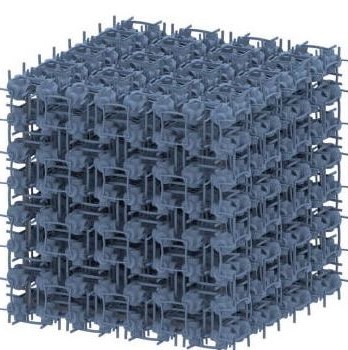The new composite, which uses mixtures of polypropylene and polyethylene with multi-walled carbon nanotubes, achieves impressive impact resistance
A new type of 3D-printed metamaterial made by combining Polyethylene and Polypropylene with carbon nanotubes is stronger and lighter than similar forms of aluminum, the scientists concluded.
What are metamaterials?
Carbon nanotube-plastic composite plate lattice metamaterials belong to a class of artificially created cellular solids engineered and engineered to manifest properties that do not occur in the natural world.
In a new article published in the journal Materials & Design, a team led by engineers from the University of Glasgow describes how they developed a new cellular plate-lattice metamaterial capable of impressive impact resistance. This material could lead to the development of safer, lighter and more durable structures for use in the aerospace, automotive, renewable and marine industries.
3D printed metamaterial
Plate-lattice metamaterials are cubic structures made of layers of plates that intersect and exhibit unusually high stiffness and strength despite a significant amount of space between the plates. Those gaps, which are a property engineers call porosity, also make plate lattices unusually light.
In their research, the scientists sought to define whether the new forms of plate-lattice design, made from a composite of plastic nanotubes they developed, could produce a metamaterial with even more advanced properties of stiffness, strength and toughness.
This composite uses common Polypropylene and Polyethylene blends with multi-walled carbon nanotubes.
Towards the manufacture of safer and lighter cars
The researchers used their nanoengineered filament composite as a raw material in a 3D printer, which fused the filaments to build a series of lattice plate designs. Those designs then underwent a series of impact tests – a 16.7 kg mass was dropped from a variety of heights to determine the material’s ability to withstand physical shock.
First, the team tested three types of typical plate trusses that they designed and built: a simple cube formed from the intersection of three plates, a more complex cube with additional intersection plates, and a multi-faceted design. These typical plate lattices were made in two batches: one of Polypropylene and the other of Polyethylene.
They then tested three more “hybrid” plate lattices that incorporated features from the simplest designs in the early experiments: a simple cube / complex cube hybrid, a simple cube / multifaceted hybrid, and one that amalgamated all three. Again, lots were made of Polypropylene and Polyethylene.
The hybrid design, combining elements of the three typical plate-lattice designs, proved to be the most effective at absorbing impacts, with the polypropylene version showing the highest impact resistance. Using a measure known as specific energy absorption, which scientists use to determine a material’s ability to absorb energy relative to its mass, the team discovered that the Polypropylene hybrid plate lattice could withstand 19.9 joules per gram, better performance than similarly designed microprocessors.
Dr. Shanmugam Kumar, professor of composite and additive manufacturing at the James Watt School of Engineering, led the research project. The research team also involved mechanical and chemical engineers from Khalifa University in Abu Dhabi and Texas A&M University in College Station.
Kumar said: “Advances in 3D printing are making it easier and cheaper than ever to manufacture the kinds of complicated geometries with custom porosity that underpin our plate-lattice design. Manufacturing these types of designs on an industrial scale is becoming a real possibility.
“One application for this new type of lattice plate could be automotive manufacturing, where designers are constantly striving to build lighter bodies without sacrificing safety during crashes. Aluminum is used in many modern car designs, but our lattice plate offers higher impact resistance, which could make it useful in such applications in the future.

